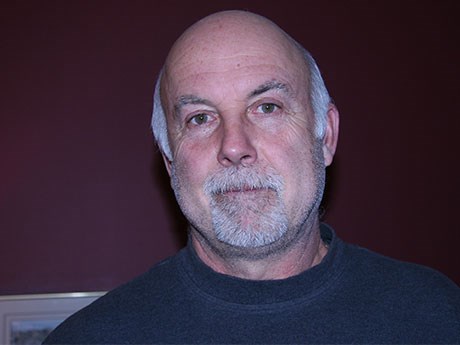Quick, easy and now more powerful
VLF surveys have always been a quick and easy way for prospectors to locate areas of conductivity and potential mineralization. Now, thanks to a proprietary software program co-developed by University of Lisbon geophysics professor Fernando Monteiro Santos and Shaun Parent, president of Superior Exploration, Adventure and Climbing, VLF is also a lot more powerful.
The unlikely connection between a Portuguese geophysicist and a prospector from Batchawana Bay, 70 kilometres northwest of Sault Ste. Marie, occurred several years ago when Parent was doing a VLF survey in South America.
“We were doing some VLF surveys in Chile at 4,000 metres and it was taking us too long to process the Fraser filter by hand, so we went online and found out about this software that Fernando wrote for his PhD thesis,” recalled Parent.
“Fernando sent it to us to try out and we corresponded back and forth, suggesting changes along the way.”
Parent has made three trips to Lisbon to help fine-tune the software and has field-tested it on three continents.
VLF stands for very low frequency and refers to radio waves in the range of 3 kHz to 30kHz. According to Parent, prospectors have been using VLF since the mid-’60s, piggybacking on a network of transmitters the U.S.
Navy employs to communicate with submarines around the world.
Using a hand-held EM-16 receiver, prospectors are able to discern different resistivity contrasts and pick up ground conductors, explained Parent.
In North America, Parent uses a transmitter in Cutler, Maine, transmitting at 24.8 kHz, and another in La Moure, North Dakota, transmitting at 25.2 kHz.
The software co-developed by Santos and Parent makes VLF more useful because it lets prospectors and geologists distinguish between surface and bedrock conductors.
“VLF is on its way back,” said Parent. “People got away from it because all you could do was Fraser filters. You couldn’t do inversions. Now that you can do inversions, it’s a fast way to go in and ground- proof targets identified by airborne surveys. With the software, you can tell if they’re bedrock conductors or just conductive overburden. You can also obtain a depth estimate, dip and apparent width of the conductor.”
The software, called VLF2DMF, allows Parent to take into account the resistivity of the ground.
“If I enter a resistivity of 100 ohms, I can see down an average of 40 metres. If I change the resistivity in the model to 500 ohms, I can see down 80 metres and if I change it to 1,000 ohms, I can see down 150 metres.”
The software will account for a conductive clay bed at surface, but it will also pick up conductors at greater depth.
“In the old days, you couldn’t do profiles,” said Parent. “You could just do Fraser filters which showed peaks (areas of conductivity), but there was no way of determining how deep they were.”
One of the advantages of VLF surveys “is that you don’t need an exploration permit. You don’t need to cut lines.
You just need a hand-held GPS. Other methods require you to cut lines because you’re dragging cables and carrying heavy equipment through the bush.”
An IP (induced polarization) or time domain surveys can cost between $2,000 and $3,000 per kilometre, said Parent.
VLF is much less expensive, easier and faster.
“One kilometre of time domain might take a day, whereas one kilometre of VLF might take us an hour,” he said.
A prospector or geologist surveys the target using perpendicular lines, and records a reading every 20 metres, noting the GPS co-ordinates as he goes.
“You want the signal to be perpendicular to the target to induce more current,” explained Parent. “The signal propagates through the ground, and if it hits a conductive sheet, it induces a secondary field that the VLF picks up.”
The values and GPS co-ordinates are logged, entered into an Excel spreadsheet and imported into the software, which produces a model of what’s in the ground based on the VLF.
Parent has conducted several case histories to prove the effectiveness of the software.
“In one case history, he found an outcrop that had chalcopyrite and chalcocite right where the VLF projected it to surface and, on a cliff face, we found malachite. We chased that horizon, ran more VLF lines and got a horizon that’s 200 metres long and up to 30 metres wide. The area had been prospected before and everybody walked away from it. It’s a property that’s four kilometres off Highway 17.”
Parent also completed several VLF test lines for Wallbridge Mining in Sudbury, for which the software identified and outlined a drilled-off orebody and outlined the edges of an offset dyke.
Additional surveys have been completed in Ireland and Portugal, as well as closer to home in Batchawana Bay, where Parent discovered a series of sulphidebearing breccia pipes with similar characteristics to the East Breccia, Breton Breccia and West Breccia deposits.
The last breccia pipe discovered in Batchawana using geophysics was in 1998 with an Induced Polarization survey. He also discovered several new gold bearing shears and a massive sulphide deposit, both of which had geophysics completed over them in the past.
Parent’s company, Superior Exploration, plans to hold onto the software for now and perform VLF surveys as a service.
“We’ve done enough case studies, so we’re ready to start commercializing it,” he said.



.jpg;w=120;h=80;mode=crop)